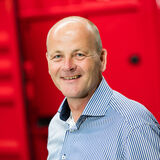Emissions during dismantling activities reduced by 90%
The coming years various old gas wells will be dismantled on multiple locations in the Netherlands. Many of these locations are in or near Natura 2000 areas, which means strict rules regarding emissions apply. The clever use of gensets with Denox-installations, and if possible in combination with the grid, ensures this job can be completed as clean as possible.
The caravan that travels through the north of the Netherlands in 2020 is an interesting one. A large “P&A-rig”, a machine that removes drilling pipes from the ground rather than inserting them, is set up on every location, along with all accessories. Below that: two large container gensets from Bredenoord, each with a Denox-installation that captures NOx and converts it into water, among other substances. “No drilling location is the same,” Marten Boersma and Henriët Jager of the NAM explain. “Sometimes we spend months at the same location, sometimes only six days, therefore every location requires a custom energy plan.”
The Denox-installation ensures the genset’s emission is reduced by 90%. Without this we cannot receive a permit to work in Natura 2000 areas under the current legislation, not when using a combination with the grid.
Extra strict demands
For various years the option of using the grid has been involved in drafting the plans per location. Sometimes it is cheaper and results in lower emission. However, during peak demand the grid cannot keep up with the energy demand. This can be solved by using gensets, but the changes in NOx emission legislation formed an additional challenge. Senior Electrical Engineer Boersma: “With a ten year old genset, such as ours, the rules cannot be complied to, which is why we began looking for a solution. Bredenoord had provided us with Denox-gensets before at a drilling location of ours and is very adept at planning and setting up the combination of the grid and a genset. Because of this they have become a default part of our caravan.” Bredenoord modified the combination of the genset and Denox-installation so that the full installation is lower and thereby able to be transported on a low trailer.
Silent root canal treatment
Closing a gas well is comparable to a root canal treatment, says Jager. “We first remove most of the pipes from the ground, because we are not allowed to leave them in the substrate. This has been agreed on and laid down at the start of the operation. After that we insert multiple cement plugs at various depths in the well. Even if the well is near empty we still must prevent any remaining gas from being released. After monitoring the plugs for a while to ensure they work well, we return the terrain, which we often rented from a landowner, to its original state.” Some locations are repurposed in service of the energy transition. Jager: “Sometimes we have a lot of infrastructure, such as pipes, that can also be used for hydrogen or biofuel. It would be a waste not to use them, so we actively look if we can turn these into an energy hub.” Jager has visited various locations, yet the combination of the grid and gensets is quite the sensation. “It is much quieter, which the staff on location also strongly appreciates.”

Learning a lot about consumption
Bredenoord's experts and the dismantling teams are constantly working together to optimize the installation. Boersma: “This is the first time we approach the power supply of a project this way, so it’s difficult to decide in advance what the power demand will be. Fortunately through online monitoring we can track the power demand in real time. It is a real eye opener, providing valuable knowledge for the continuation of this trajectory.” An evaluation with the engineers of all parties involved follows after finalizing every location, to see what can be done better in the future. “There are always some growing pains and progressive insights, which is why we are glad to be working together. We are even considering to add energy storage systems on locations where we’re only working briefly. However, with our large power demand that may be a challenge.” Bredenoord’s Battery Box can form a solution by combining two of these battery systems with a Denox-installation.
Denox indispensable
Now that the first wells have been tidied up, it is clear not only on paper but also in practice that this energy solution works. “The Denox-installation reduces emission by 90% when we have to use the genset,” says Boersma. “Without that we cannot even acquire a permit in or near Natura 2000 areas under the current legislation, not even if we combine the genset with the grid. Bredenoord’s 24/7 service is also quite convenient. The installation has worked just fine for months, but one time one fuse had blown. Of course this happened in the middle of the night. Our staff was very glad when someone from Bredenoord was on site within an hour and a half to get the installation back on track.”
Contact usThe system was first thoroughly tested at Bredenoord’s headquarters. The cooperation with Bredenoord goes well. We strongly appreciate the technical advice, the input on solutions and support on location.





-c01f2eed9f.svg)



